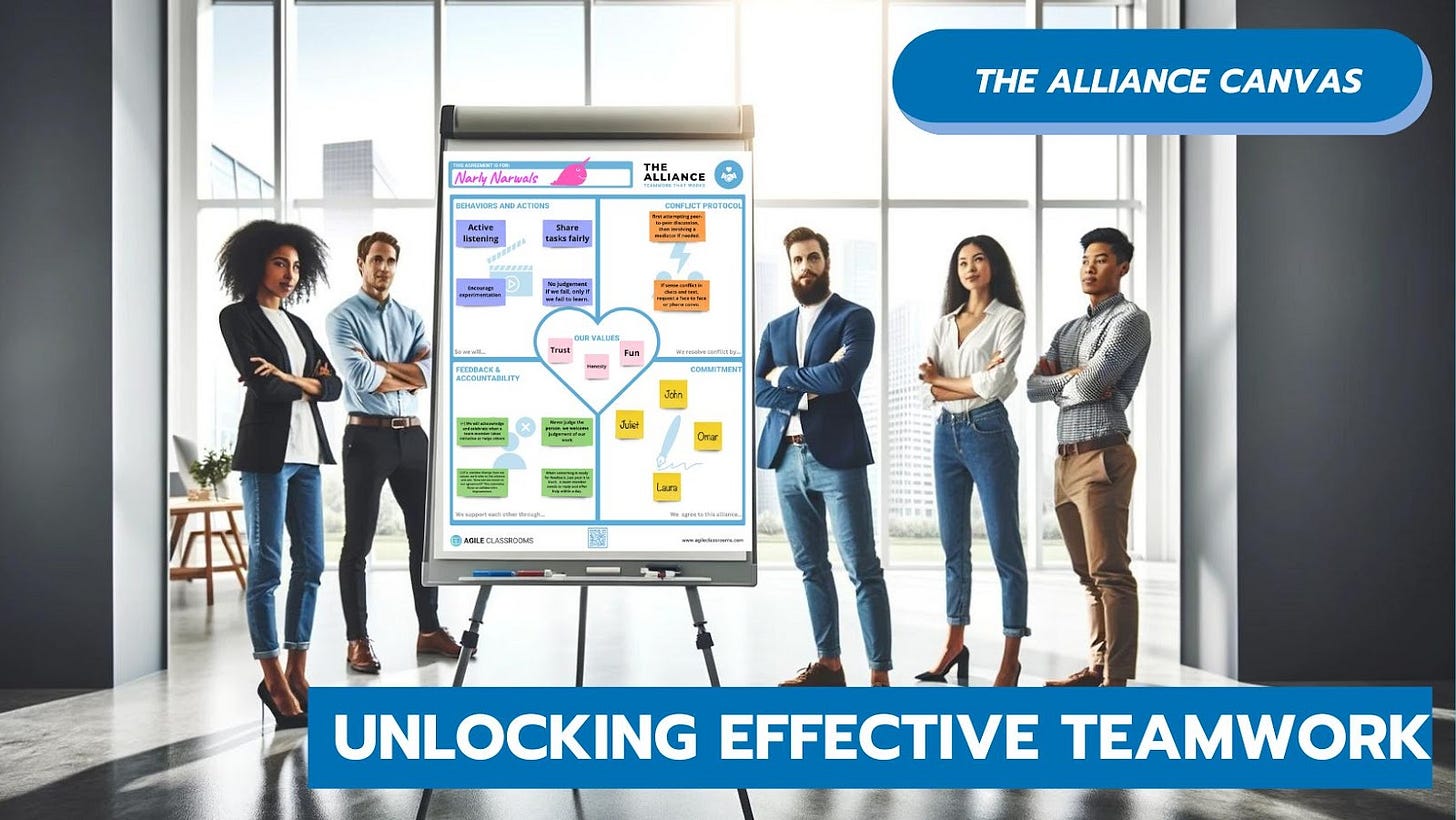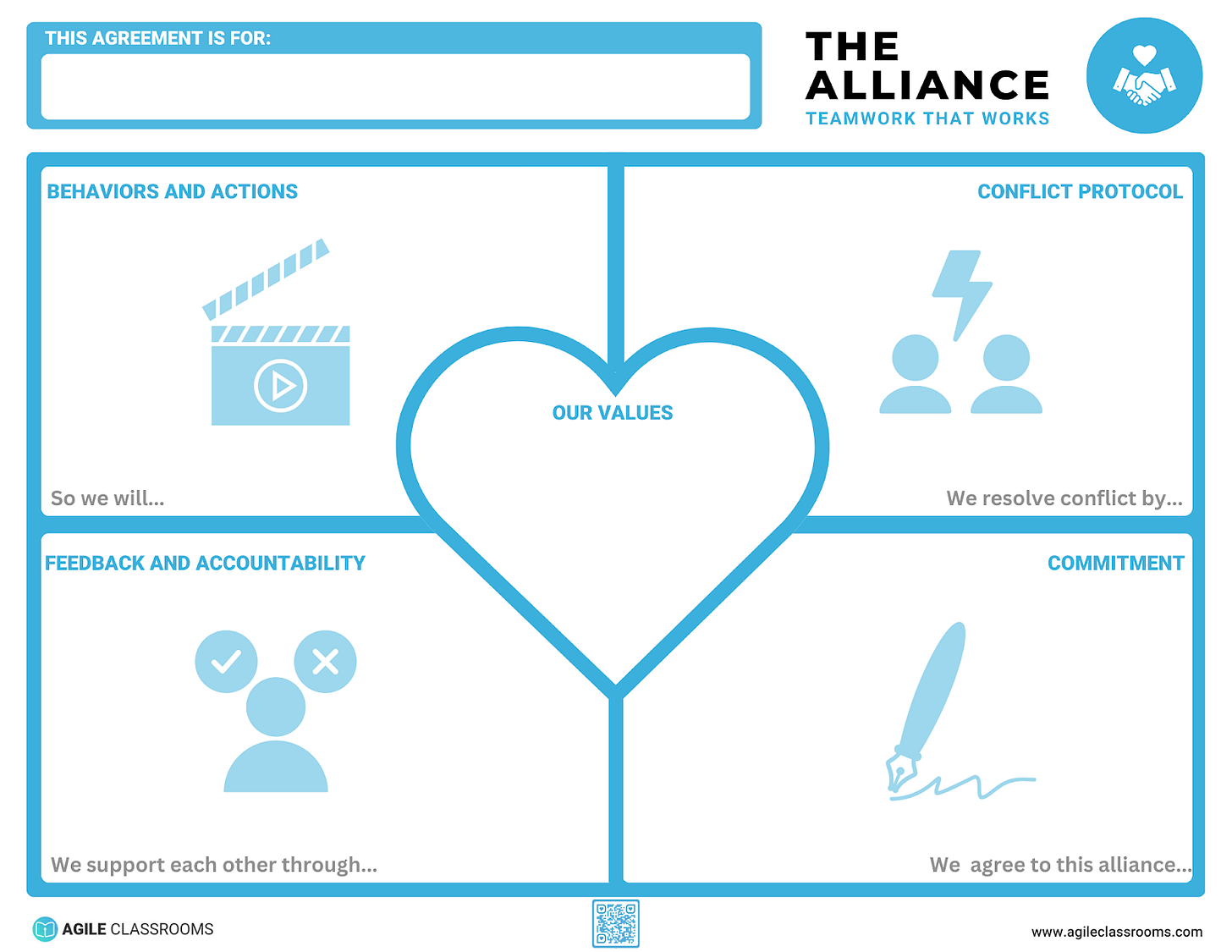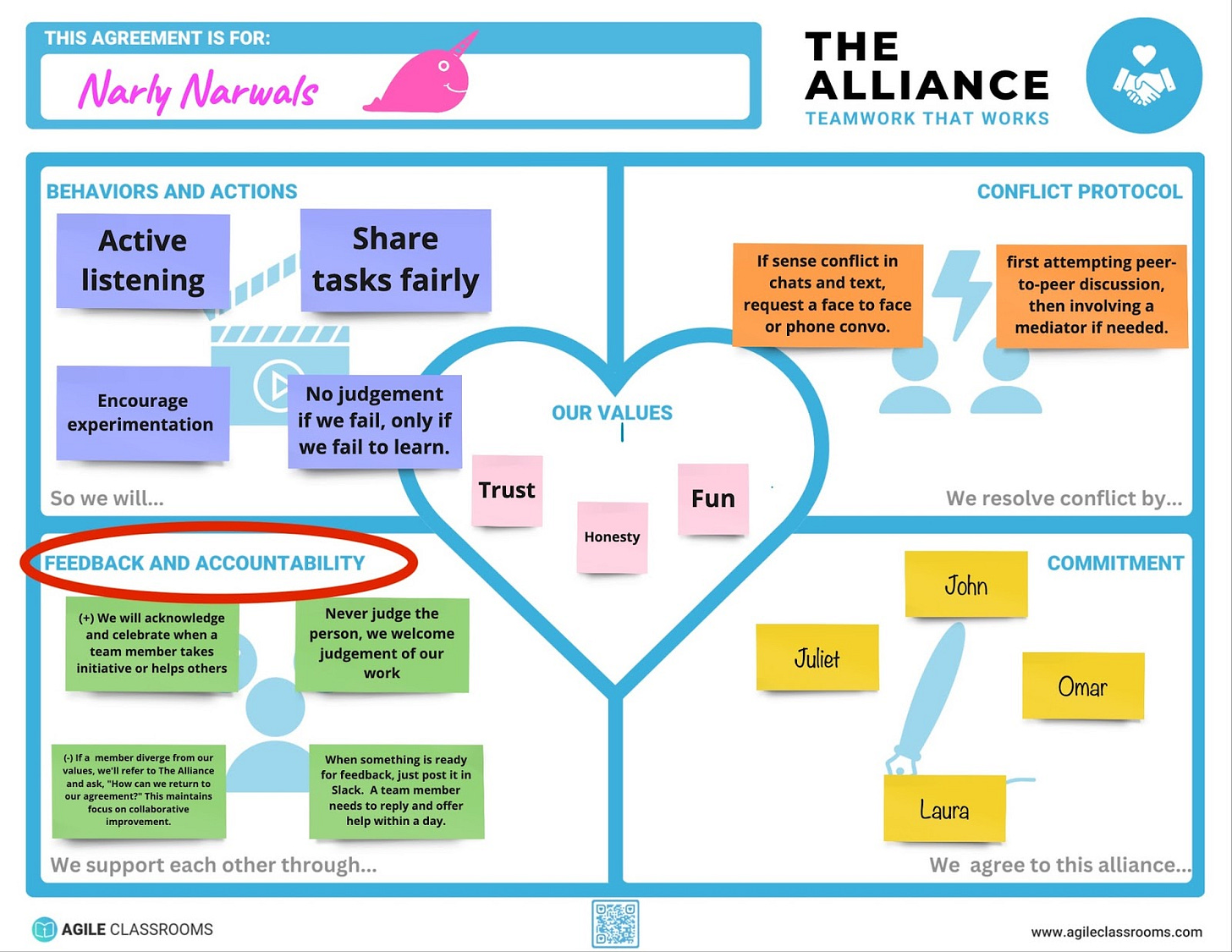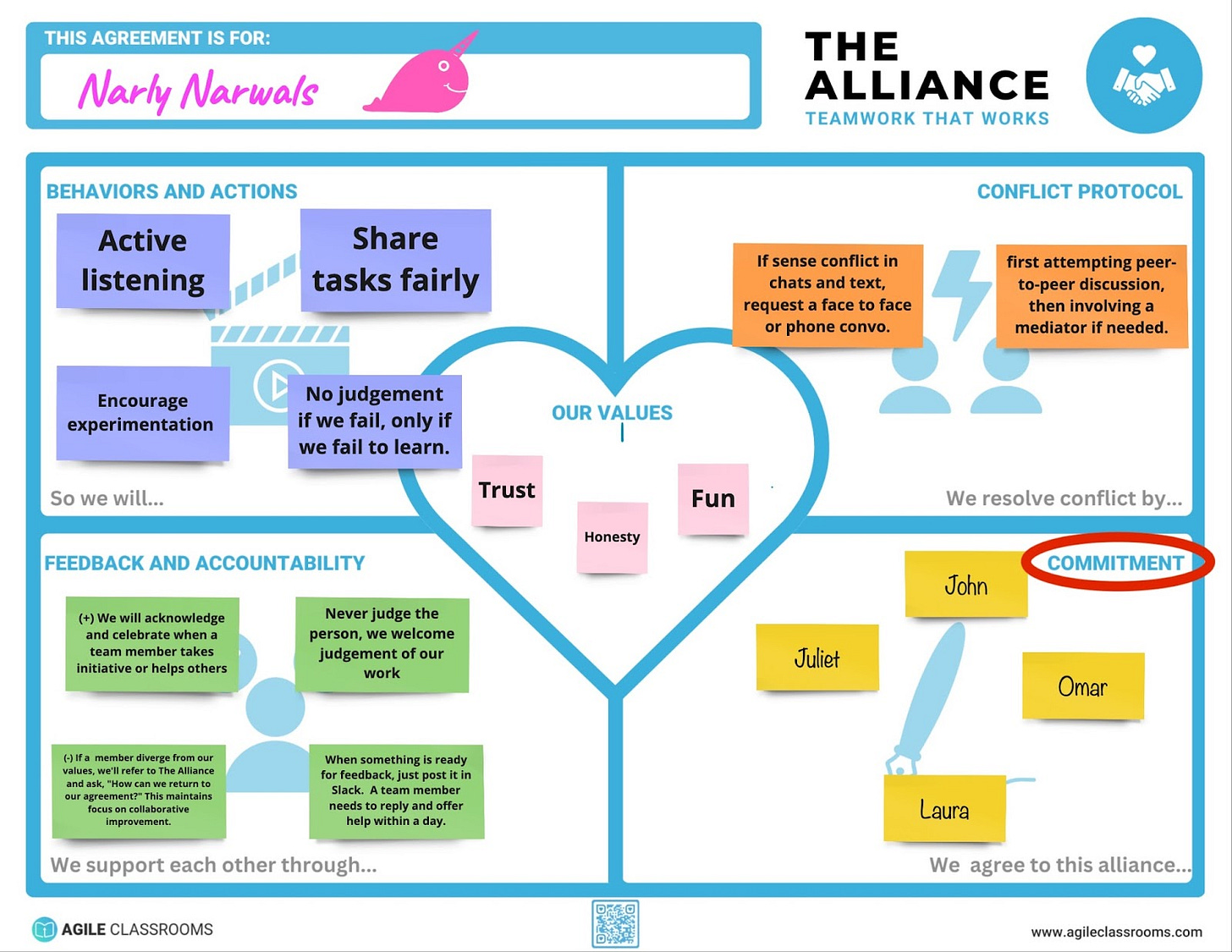Since the dawn of human civilization, the need for effective collaboration has been at the heart of human progress. From our ancestors coordinating in hunter-gatherer societies to children negotiating the rules of a playground game and onto modern cross-functional teams crafting groundbreaking innovations, working together has been a constant. Yet, the collaboration journey has never been without its problems.
Common Teaming Problems:
Accountability becomes fragmented in group settings.
Unclear guidelines for healthy collaboration.
Interpersonal drama and conflict affecting group dynamics.
Over-reliance on a leader, facilitator, or teacher for conflict resolution.
These challenges have always trailed closely behind, like shadows to the light of cooperative achievement. Addressing and navigating these challenges is not just a necessity but a skill honed by humanity over millennia.
Teams Are We, Not Just A Collection of I’s
When we engage in collaborative efforts, we transform a group of individuals into a dynamic, unified entity—a team. This concept transcends mere groupings of people; it's about crafting an identity greater than the sum of its parts. The challenge arises when this shared identity isn't clearly articulated. Without this, collaboration devolves into a disjointed effort of individuals merely completing tasks rather than a cohesive team striving towards a common goal. Effective teamwork requires not just cooperation but clearly defined and mutually understood guidelines that shape how "we" work together, setting the team apart from the individualistic approach.
Turning a group into a team isn't always smooth. It's about finding common ground amid different views and ways of working. This part of teamwork is crucial: understanding and working through these rough spots makes us stronger. Now, let's explore what factors contribute to the challenges we mentioned earlier.
Five Factors That Contribute To Teamwork Challenges:
Cognitive Diversity: Balancing Perspectives: Diverse perspectives are valuable in solving complex challenges but can lead to friction due to differing values and beliefs. Unifying around a common team culture is essential.
Conflict Resolution: Handling Disagreements: Teams often lack a shared method for resolving conflicts, leading to unresolved disputes and ongoing discord.
Feedback Dynamics: Overcoming Defensiveness: In the absence of a supportive feedback culture, defensiveness can obstruct growth and collaboration.
Accountability Gets Lost in Team Dynamics: Individual accountability can become unclear in teams, especially self-managing ones, leading to a loss of responsibility.
Commitment: Prioritizing Team Over Individual: A lack of commitment to the team's collective goals over individual preferences and agendas can significantly undermine teamwork.
Understanding these team challenges guides us to the significance of group norms, a concept highlighted by Google's Project Aristotle. Google’s research on what made teams great in their organization emphasizes how positive group norms can dramatically impact its effectiveness. By recognizing and cultivating these norms, teams can transition from facing common obstacles to achieving streamlined collaboration. This article provides a simple visual tool to help teams quickly and effectively craft their team norms. We call this The Alliance Canvas. It has been used with students in classrooms to produce professionals in shared team rooms.
The Alliance Canvas has five sections that preemptively tackle these challenges from the beginning. Groups co-create the contents of these sections together.
1. Values: The set of shared values of the team. Placed at the core of the alliance, these values define the team's culture and guide their actions.
2. Behaviors: Observable actions aligned with values. These action statements detail how the team will live out each value.
3. Conflict Resolution: A safety plan for collaboration outlining how conflicts will be identified and resolved.
4. Accountability and Feedback: Cornerstones in building a positive organizational culture. Includes both reinforcing (positive feedback and accountability) and redirecting (support and constructive guidance) aspects.
5. Commitment: A pivotal moment where the team collectively agrees and understands the shared values, behaviors, and conflict resolution strategies. Individual signatures, mutual permission, visible reminders, and a dynamic document ensure commitment's strength and relevance.
Unpacking The Alliance Canvas
Each part of The Alliance Canvas plays a crucial role in team success. Next, we'll unpack these sections one by one, giving you the insights to bring them to life in your team. Let’s dive in and see how each piece comes together to strengthen collaboration.
Our Values and Behaviors: The first two sections of The Alliance Canvas are about defining the team's shared identity through values and behaviors.
In the Values section, teams choose core values guiding their collaboration. Having a values list to refer to can speed this part up. For example, a team might choose "innovation" as a value. This means they commit to fostering a culture of experimentation and learning from failures.
The Behaviors section translates values into actionable steps. It outlines how the team will embody these values in their actions. For instance, if "innovation" is a value, the team might decide to "We encourage experimentation and learn from failures" as one of their behaviors. These sections allow teams to intentionally design their culture based on shared beliefs and behavior, forming the foundation for effective collaboration.
Conflict Resolution: Navigating Storms: Conflict doesn't imply disliking or disrespecting one another. It's a natural part of human interactions, even with those we care about. Conflict is bound to happen when people rely on each other—it's unavoidable. That's why it's crucial to be prepared for how we handle conflicts when they arise.
Attempting to resolve conflicts in the heat of the moment can be challenging, especially when emotions are running high. This section is all about proactive conflict resolution strategies.
Teams can establish a basic conflict escalation pattern:
Individual Reflection: Take a moment to consider your role in the situation.
Direct Conversation: Engage in a direct and open conversation with those involved in the conflict.
Neutral Mediation: If needed, involve a neutral third party, like a team facilitator or coach, to mediate the discussion.
Further Escalation: In cases where conflicts persist and become more serious, consider escalation to HR in professional settings or the teacher if it is in classroom settings.
A simple statement like “We talk it out face to face” or “If we feel triggered, do not text or message, request a real conversation with the other person”, can suffice.
However, teams can choose from approaches like Nonviolent Communication (NVC) or opt for other effective methods such as Crucial Conversations for more structured and in-depth conflict resolution. These structured approaches provide valuable tools to navigate conflicts effectively and maintain harmonious teamwork. Of course, these take some learning and practice.
Accountability and Feedback: Strengthening Commitments
One of the most significant challenges in teamwork is holding each other accountable for agreements and commitments. It also involves the art of offering and receiving feedback constructively without becoming defensive.
Accountability refers to the responsibility of team members to fulfill their commitments, agreements, or promises made within the team. It involves being answerable for actions and ensuring that promises are delivered.
Feedback is the process of providing information, comments, or observations to team members about their actions, behaviors, or work performance. The purpose of feedback is to help each other improve, grow, and make necessary adjustments based on the input received.
In teams, especially those aiming for self-management, individuals may have previously relied on a teacher or manager to handle accountability and feedback. However, establishing a proactive approach from the outset can make a significant difference.
Here's how teams can approach accountability and feedback:
Permission to Hold Accountable: From the beginning, establish an environment where team members have permission to hold each other accountable.
Constructive Feedback: Emphasize the importance of providing feedback in a constructive and supportive manner. It's about helping each other improve and grow.
Mutual Responsibility: Encourage a sense of mutual responsibility, where team members have permission and expect their teammates to hold them accountable and provide and receive feedback.
Flexibility When Plans Change: Recognizing that unforeseen situations may affect commitments and emphasizing the importance of promptly communicating any changes for adaptation
Accountability and feedback come in two forms:
Reinforcing: Celebrate positive contributions and moments when team members live up to their promises and provide quality work and results.
Redirecting: Offer support and guidance to steer team members back on track when things don't go as planned. This includes understanding the reasons behind deviations and collaboratively finding ways to realign with agreed principles and the expected quality of work.
This proactive approach to accountability and feedback fosters a culture of trust and collective responsibility within the team.
Commitment: Strengthening Bonds Crafting The Alliance Canvas culminates in a defining moment for the team - the commitment to shared values, behaviors, and conflict resolution strategies. This commitment goes beyond words; it's about translating our intentions into action.
When team members sign The Alliance Canvas, they express their dedication to upholding its principles. Research suggests that the act of signing a commitment significantly boosts compliance and integrity.
Here's what the commitment involves:
Individual Signatures: Each member signs, symbolizing a personal pledge to uphold The Alliance's principles.
Mutual Permission: Signing signifies not only commitment but also grants permission to peers to offer support and guidance, fostering a collaborative culture.
Visible Reminder: Display the signed Alliance prominently, reinforcing its importance in daily interactions and decisions.
Dynamic Document: The Alliance evolves with the team, allowing revisions and reaffirmations as needed, ensuring ongoing relevance and impact.
Signing The Alliance Canvas solidifies the team's commitment and cultivates a culture of trust, collaboration, and collective responsibility.
An Example of The Alliance Canvas
Now, let's see The Alliance Canvas in action. Below is an example of a completed Alliance Canvas, providing practical insights into how teams can articulate their shared values, behaviors, and commitments. Take a moment to explore this real-world example and consider how it can inspire your team's collaborative journey:
Get Your Copy
Ready to strengthen your team's collaboration and overcome these challenges? Download The Alliance Canvas and unlock the potential of streamlined teamwork!










